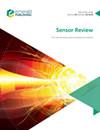基于LaF3固体电解质薄膜的微型室温氧传感器
IF 1.4
4区 工程技术
Q3 INSTRUMENTS & INSTRUMENTATION
引用次数: 0
摘要
目的在室温下密闭空间内检测氧气气体对监测精密设备的工作过程尤为重要。本研究旨在提出一种工作在30°C左右的小型化、低成本、大规模生产的O2传感器。采用MEMS技术,研制了基于氟化镧(LaF3)固体电解质薄膜的O2传感器。传感器的原理为原电池H2O, O2, Pt | LaF3 | Sn, SnF2 |,其中Sn薄膜采用磁控溅射法制备,LaF3薄膜采用热阻蒸发法制备。在30℃、97.0% RH条件下,通过预处理,传感器对40%氧浓度的响应信号由1.9 mV增强到46.0 mV。在温度为30℃~ 50℃,湿度为32.4% ~ 97.0% RH的条件下进行的测试表明,输出电动势(EMF)与氧浓度的对数呈线性关系。在耦合模式下,传感器的灵敏度随湿度和温度的增加而增加,传感器的电动势在不同温度和湿度下都符合能思特方程。实际意义本研究可应用于室温下密闭空间内,在没有电源的情况下安全监测氧气浓度低于25%。获得了温湿度耦合与传感器响应之间的关系。纳米薄膜材料与MEMS工艺相结合。期望在未来得到实际应用。本文章由计算机程序翻译,如有差异,请以英文原文为准。
A micro room temperature oxygen sensor based on LaF3 solid electrolyte thin film
Purpose
Detecting O2 gas in a confined space at room temperature is particularly important to monitor the work process of precision equipment. This study aims to propose a miniaturized, low-cost, mass-scale produced O2 sensor operating around 30°C.
Design/methodology/approach
The O2 sensor based on lanthanum fluoride (LaF3) solid electrolyte thin film was developed using MEMS technology. The principle of the sensor was a galvanic cell H2O, O2, Pt | LaF3 | Sn, SnF2 |, in which the Sn film was prepared by magnetron sputtering, and the LaF3 film was prepared by thermal resistance evaporation.
Findings
Through pretreatments, the sensor’s response signal to 40% oxygen concentration was enhanced from 1.9 mV to 46.0 mV at 30°C and 97.0% RH. Tests at temperatures from 30°C to 50°C and humidity from 32.4% RH to 97.0% RH indicated that the output electromotive force (EMF) has a linear relationship with the logarithm of the oxygen concentration. The sensitivity of the sensor increases with an increase in both humidity and temperature in the couple mode, and the EMF of the sensor follows well with the Nernst equation at different temperatures and humidity.
Practical implications
This research could be applied to monitor the oxygen concentration below 25% in confined spaces at room temperature safely without a power supply.
Originality/value
The relationship between temperature and humidity coupling and the response of the sensor was obtained. The nano-film material was integrated with the MEMS process. It is expected to be practically applied in the future.
求助全文
通过发布文献求助,成功后即可免费获取论文全文。
去求助
来源期刊

Sensor Review
工程技术-仪器仪表
CiteScore
3.40
自引率
6.20%
发文量
50
审稿时长
3.7 months
期刊介绍:
Sensor Review publishes peer reviewed state-of-the-art articles and specially commissioned technology reviews. Each issue of this multidisciplinary journal includes high quality original content covering all aspects of sensors and their applications, and reflecting the most interesting and strategically important research and development activities from around the world. Because of this, readers can stay at the very forefront of high technology sensor developments.
Emphasis is placed on detailed independent regular and review articles identifying the full range of sensors currently available for specific applications, as well as highlighting those areas of technology showing great potential for the future. The journal encourages authors to consider the practical and social implications of their articles.
All articles undergo a rigorous double-blind peer review process which involves an initial assessment of suitability of an article for the journal followed by sending it to, at least two reviewers in the field if deemed suitable.
Sensor Review’s coverage includes, but is not restricted to:
Mechanical sensors – position, displacement, proximity, velocity, acceleration, vibration, force, torque, pressure, and flow sensors
Electric and magnetic sensors – resistance, inductive, capacitive, piezoelectric, eddy-current, electromagnetic, photoelectric, and thermoelectric sensors
Temperature sensors, infrared sensors, humidity sensors
Optical, electro-optical and fibre-optic sensors and systems, photonic sensors
Biosensors, wearable and implantable sensors and systems, immunosensors
Gas and chemical sensors and systems, polymer sensors
Acoustic and ultrasonic sensors
Haptic sensors and devices
Smart and intelligent sensors and systems
Nanosensors, NEMS, MEMS, and BioMEMS
Quantum sensors
Sensor systems: sensor data fusion, signals, processing and interfacing, signal conditioning.
 求助内容:
求助内容: 应助结果提醒方式:
应助结果提醒方式:


